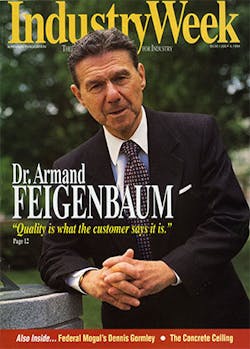Dr. Armand Feigenbaum on the Cost of Quality and the Hidden Factory
Editor's Note: This is the second installment of a two-part interview conducted with Dr. Armand V. Feigenbaum. You can read the first installment at Dr. Armand Feigenbaum on Managing for Quality (Part 1).
IW: Let's speak about cost accounting. I believe both you and Dr. Juran emphasized quality cost accounting and mining the cost of failure out of a process.
Feigenbaum: Absolutely. After 75 years of cost accounting in this country, most companies still don't know what things cost. That's a reality. And because of that, many decisions with respect to what is the best way to go for business or quality improvement are made incorrectly. Basically, quality cost deals with the effectiveness through which you deliver customer satisfaction. But traditional cost accounting doesn't pick up on that. That's the point. By cost of quality I mean two things: the cost of getting it right and the cost of failing to get it right.
Today, in major American companies, that can be 25% or more in sales, most of which is failure. In my experience, that is created by what I call the hidden organization or hidden factory: that part of your organization that exists to do bad work -- not because you want to do bad work, but because the whole process is such that you are driven into it. Now the problem with downsizing and restructuring is that you will cut off the good heads with the bad heads. You'll simply move costs from one part of the organization to another without ever getting at them. This is why restructuring without a change in your way of working in terms of quality is like a weight-reduction program. Without a change in your lifestyle, it doesn't stick.
Most companies still don't know what things cost. That's a reality. And because of that, many decisions with respect to what is the best way to go for business or quality improvement are made incorrectly.
IW: What is the impact of the hidden organization on American industry as a whole?
Feigenbaum: From an operating point of view, anywhere from about 20% to 40% of total capacity of many American companies is tied up in this hidden organization. Part of the reason is that it is never addressed because of this silo effect -- going at the improvement on a bits-and-pieces basis.
Another factor is that after 10 or 15 years of automation-computerization- if anything, we've increased the hid den factory. Why? Because in too many cases we've simply automated waste. And that is what I mean by results-driven quality. That is a center point where you begin to set objectives. If you're at a quality cost of25% and you are competing with a 5% company, heaven help you.
At General Systems we looked at what widespread application of total quality and quality cost would mean to the gross domestic product of the United States. We came up with a hard number, widely accepted by the economics community: 7% of gross domestic product. That may not seem like a big number, but understand that we have only a 2% or 3% GDP growth per year. From my point of view, when you look at epitaphs, the thing I ask myself is, why in heck, after all these years, is quality cost accounting so confined in its use?
IW: What is the answer to that question?
Feigenbaum: The answer is that you have to understand results-driven total quality -- that quality does not exist as an island. Quality exists to serve the increased customer value, investor value, and the basic purposes of the company. And you measure that through quality cost. You connect them. Now when you do that, many of the uncertainties in terms of senior management accepting total quality and how flaky it can be disappear like slush in the hot sun.
IW: In the final analysis, companies are a reflection of the people in them, the human element. One of your concepts is putting the fizz, the enthusiasm, back into people's jobs. Would you please touch on the human side of management?
Feigenbaum: What you can do is make it possible for every man and woman in the organization to be his or her own job entrepreneur by providing him and her with the tools, the resources, the objectives, the support to do his or her own quality improvement. Now you can't do that with speeches. Training courses that are generic simply don't do it. You go back to your workplace, and you find things haven't changed. The processes are still ambiguous. You're still being nickled and dimed to death by too many pieces of paper.
It can only start with results-driven process improvement whereby you make it more and more possible for every man and woman in the organization to do the job better. What it means as a manager is exposing yourself, personally.
A great leader is someone of whom the people say, "We did it ourselves."
IW: The people around you pick up on that, and that will in turn generate a certain enthusiasm?
Feigenbaum: Absolutely. Because you become real. You become true. You become genuine: There's an old Chinese proverb that tries to distinguish between bad, good, and great leaders. It goes something like this: A bad leader is somebody from whom the people turn away. A good leader is somebody whom the people turn toward. A great leader is someone of whom the people say, "We did it ourselves."
The starting point for that kind of management has three components: passion, discipline, and populism. You have to have the passion to lay yourself on the line rather than be perceived to be bureaucratic. You've got to have the discipline to recognize that quality is a group of processes. And you've got to believe in people.
IW: Let's turn our attention to the global marketplace. Who do you see as our strongest foreign competitors, now and into the 21st century? What lessons should U.S. companies be learning from their foreign counterparts?
Feigenbaum: In the next five to 10 years we are going to look back on the competitive era we've just come out of as being warm-up practice for the kind of competitive forces we as a nation will face throughout the world. It's going to be the toughest competitive period any of us has experienced in our lifetimes. We will be facing many new Japans, and those new Japans are not companies and individuals who believe they are going to succeed through low labor costs. They are companies and countries that believe they are going to succeed on the very kinds of things we have been talking about: customer satisfaction, operating-cost leadership, and human-resource effectiveness.
Quality does not travel under a single passport. Quality levels the playing field. It's a very tough thing for some American companies to understand that even if you don't have any foreign competition or don't have any interest in export today, you need to quickly develop and offer your products and services as if you were getting some. Murphy's Law, internationalized, says that if you can get foreign competition, you will. And that is a fundamental message that many American companies just haven't gotten.

